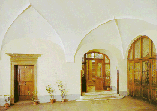 The town hall
The town hall The town hall
The town hall Link to the Historical center video clip.
Link to the Historical center video clip.The town hall dominates the north side of the square. In 1496 the Plzen people purchased the largest building in the city and converted it into a town hall. The town hall was damaged by a large fire in 1507.
On the occasion of a visit to the city by some Italian bricklayers and stonemasons, the burgesses commissioned the Italian master-builder Giovanni de Statia to reconstruct the building into a splendid Renaissance palatial residence. Today it is an imposing three-storey building.
The ground floor, made up of rustic masonry and divided from the floor above by a plain moulding, is broken by a single entrance aperture.
The first "lord's floor" is decorated with five windows with cornices, the second and third floors have smaller windows. Above the main cornice there is an attic, divided by pilaster strips into seven sections with a clock in the middle. Above the attic there is a second cornice with an architrave and frieze, above which are three little painted gables with vases and weathercocks and, along the sides, a three-sided, richly detailed shield. The hipped roof bears chimneys and a turret from the 17th century.
1907-1912 the town hall was fundamentally reconstructed by architect J.Koula, who designed a new sgraffito decoration. The original Renaissance courtyard wing was raised in 1849.
Interior of the town hall

The portal leads into the so-called "Mazhauz" with its fine clove vaulted ceiling. In the ceiling there are hooks and rings which served for holding firemen's apparatus. The imposing staircase leading to the upper floors was created during Koula's adaptation. Nowadays there is an inner door linking the town hall with the neighbouring Emperor's House and thus it is possible to enter the Lord Mayor's parlour through this house or through the main hall of the town hall, a palatial are of splendid Renaissance design. Here in the recess there is a fresco of Christ on the cross, in the background a view of the city which, judging by the monogram G.S., was painted by the town hall's master-builder in 1578. Further, there is a beautiful Renaissance hearth and above it, cast in stone, the city's Baroque coat-of-arms.
On the opposite side there is a Latin inscription on the cartouche from 1599 in honour of Emperor Rudolph II who spent some time in the city. In the 1960s a concert organ was installed in the palatial hall.
From here it is possible to enter the Lord Mayor's parlour, formerly magistrates quarters. It is decorated with a fine fresco by Frantisek J. Lux, a tableau of the victory of Emperor Charles VI over the Turks. The furniture in all these high-class rooms is pseudo-Renaissance from the time when the town hall was being adapted.
 and
Czech
and
Czech  versions.
versions.
Copyright © 2002 City of Plzen. All Rights Reserved.